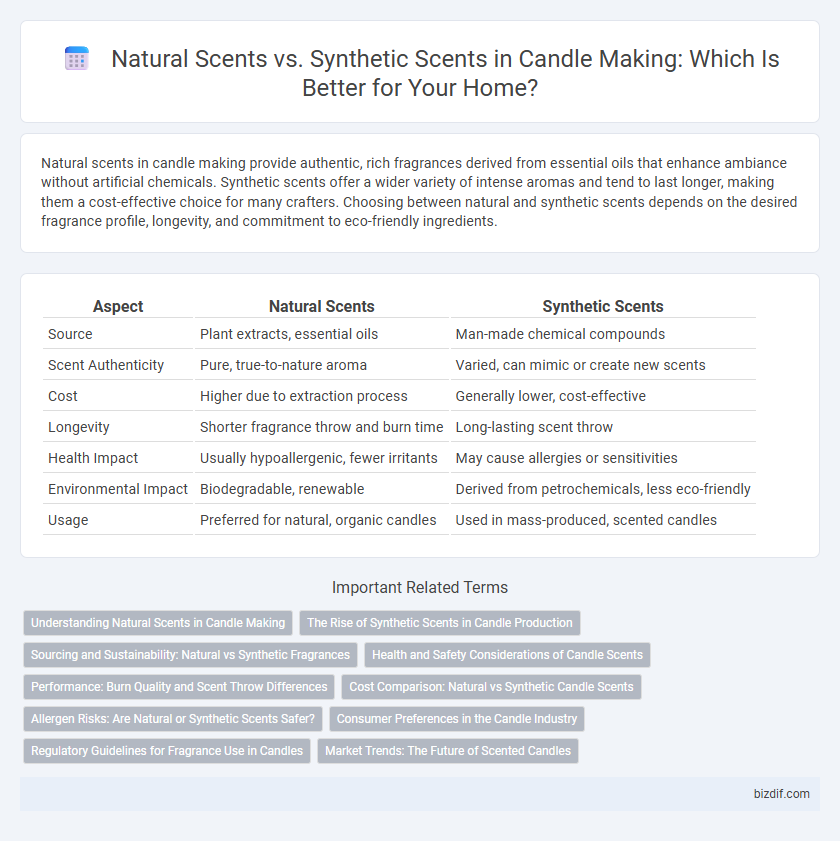Natural scents in candle making provide authentic, rich fragrances derived from essential oils that enhance ambiance without artificial chemicals. Synthetic scents offer a wider variety of intense aromas and tend to last longer, making them a cost-effective choice for many crafters. Choosing between natural and synthetic scents depends on the desired fragrance profile, longevity, and commitment to eco-friendly ingredients.
Table of Comparison
| Aspect | Natural Scents | Synthetic Scents |
|---|---|---|
| Source | Plant extracts, essential oils | Man-made chemical compounds |
| Scent Authenticity | Pure, true-to-nature aroma | Varied, can mimic or create new scents |
| Cost | Higher due to extraction process | Generally lower, cost-effective |
| Longevity | Shorter fragrance throw and burn time | Long-lasting scent throw |
| Health Impact | Usually hypoallergenic, fewer irritants | May cause allergies or sensitivities |
| Environmental Impact | Biodegradable, renewable | Derived from petrochemicals, less eco-friendly |
| Usage | Preferred for natural, organic candles | Used in mass-produced, scented candles |
Understanding Natural Scents in Candle Making
Natural scents in candle making are derived from essential oils and plant extracts, offering authentic aromas that closely mimic their source. These scents provide a complex fragrance profile and often contain therapeutic properties that enhance the candle's ambiance. Understanding the extraction methods and volatility of natural scents is crucial for achieving balanced fragrance throw and longevity in handmade candles.
The Rise of Synthetic Scents in Candle Production
The rise of synthetic scents in candle production stems from their ability to replicate a wide range of fragrances with consistent quality and lower cost compared to natural scents. Synthetic fragrances offer enhanced longevity and stronger scent throw, making them popular among manufacturers seeking reliable and vibrant aromas. Despite growing consumer interest in natural and eco-friendly ingredients, synthetic scents remain dominant in mass-market candle brands due to scalability and versatility.
Sourcing and Sustainability: Natural vs Synthetic Fragrances
Natural scents in candle making are derived from essential oils, resins, and plant extracts sourced through sustainable harvesting and organic farming practices that minimize environmental impact. Synthetic fragrances are chemically engineered in laboratories, offering consistent scent profiles but often relying on non-renewable petrochemical resources with higher carbon footprints. Choosing natural scents supports biodiversity and eco-friendly production, whereas synthetic scents prioritize cost efficiency and longevity but may pose challenges for sustainability.
Health and Safety Considerations of Candle Scents
Natural scents in candle making, derived from essential oils and plant extracts, generally offer safer health profiles with fewer harmful emissions compared to synthetic fragrances, which can release volatile organic compounds (VOCs) linked to respiratory irritation and allergic reactions. Health-conscious consumers prefer natural scents as they minimize exposure to toxins like phthalates and parabens commonly found in synthetic options. Proper ventilation is essential when burning any candle, but natural fragrance candles typically reduce indoor air pollution risks, enhancing overall safety during use.
Performance: Burn Quality and Scent Throw Differences
Natural scents in candle making often provide a subtle, authentic aroma but may have a shorter scent throw and can impact burn quality due to impurities. Synthetic scents typically offer a stronger, longer-lasting scent throw and burn more consistently because they are formulated for optimal performance. Candle makers frequently balance both types to maximize scent intensity and ensure an even, clean burn.
Cost Comparison: Natural vs Synthetic Candle Scents
Natural candle scents, sourced from essential oils and botanical extracts, typically incur higher production costs due to labor-intensive harvesting and limited availability. Synthetic candle scents, created through chemical processes, offer a cost-effective alternative with consistent aroma quality and scalability. Budget-conscious candle makers often prefer synthetic options to maximize profitability without compromising fragrance variety.
Allergen Risks: Are Natural or Synthetic Scents Safer?
Natural scents in candle making contain essential oils with complex chemical compositions that can trigger allergic reactions in sensitive individuals due to allergens like limonene and linalool. Synthetic scents are often formulated to reduce common allergens and maintain consistent fragrance profiles, potentially lowering the risk of hypersensitivity. However, individual responses vary, making it crucial to review ingredient lists and opt for hypoallergenic fragrances designed for safe indoor use.
Consumer Preferences in the Candle Industry
Consumers in the candle industry increasingly favor natural scents derived from essential oils, appreciating their authentic aromas and eco-friendly attributes. However, synthetic scents remain popular due to their affordability, longer-lasting fragrance, and wider variety of unique, customizable options. Market research shows a growing trend toward blends that combine natural and synthetic elements to balance scent quality and cost-efficiency.
Regulatory Guidelines for Fragrance Use in Candles
Regulatory guidelines for fragrance use in candles distinguish between natural scents, derived from essential oils and botanical extracts, and synthetic scents, which are chemically engineered for consistency and affordability. Organizations such as IFRA (International Fragrance Association) set strict limits on fragrance compounds to ensure consumer safety, mandating allergen disclosures and maximum concentration thresholds. Compliance with these standards ensures that both natural and synthetic candle fragrances meet health and environmental regulations while maintaining product quality.
Market Trends: The Future of Scented Candles
Market trends in scented candles show a growing consumer preference for natural scents derived from essential oils like lavender, eucalyptus, and citrus due to rising awareness of health and environmental benefits. Synthetic scents, while often cheaper and longer-lasting, face increasing scrutiny as buyers seek authentic and non-toxic ingredients in their candles. Innovations in sustainable sourcing and eco-friendly packaging also drive demand for natural fragrance products, shaping the future of the scented candle market.
Natural scents vs Synthetic scents Infographic

 bizdif.com
bizdif.com